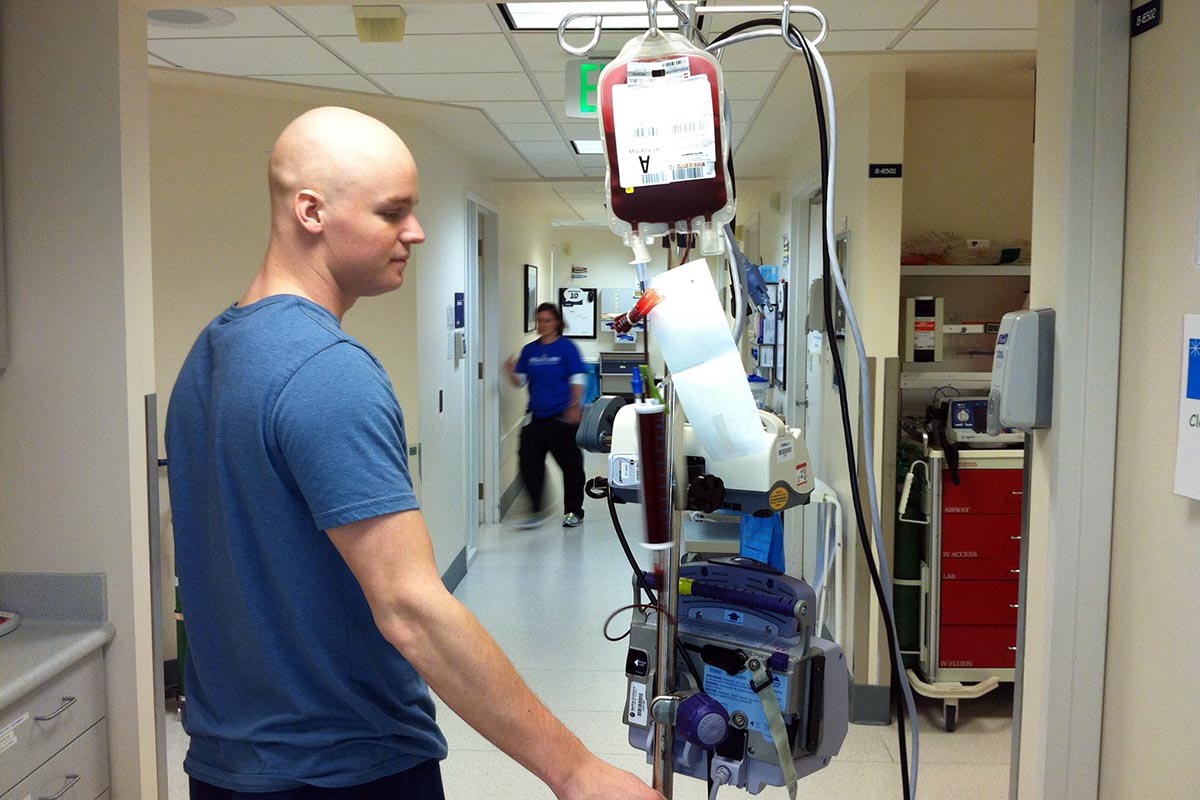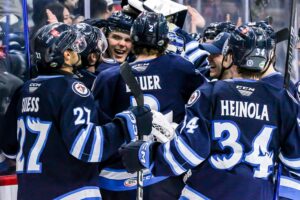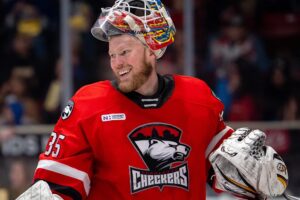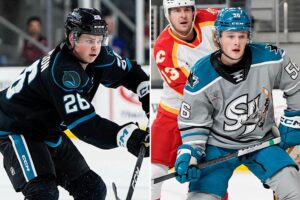by Chris Rumble with Nicole Del Villano | AHL On The Beat
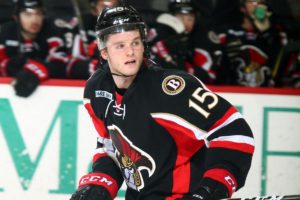
Chris Rumble earned his first American Hockey League call-up on November 1, 2016, and quickly made himself a staple on the Binghamton Senators as a good defenseman with a hard shot.
On the surface, he looks like a normal hockey player. He’s a 26-year-old that comes from a hockey family; his father, Darren, played 193 NHL games and was the Eddie Shore Award winner as the AHL’s outstanding defenseman in 1997. Chris spent the 2015-16 season in the ECHL after playing at Canisius College and now that he is with the B-Sens, he has become a fan favorite.
When you look deeper into Rumble’s story though, he is much more than just a hockey player. He’s a cancer survivor.
His Battle In His Own Words
When doctors preface the call with, “Are you sitting down?” chances are whatever is coming next probably isn’t what you want to hear. I was somewhere between the doctor’s office and the pharmacy when the call came.
Leukemia.
I just had a sore throat… maybe I was just a little more sleepy than usual. Okay, there was also a fairly prominent speckled rash on my face, but leukemia? We didn’t have any family history. I wasn’t sure how it could be true.
My only question to the doctor was, “When can I play hockey again?”
The next step felt like it would be worse than the initial diagnosis: telling my family. I called to talk to my parents and my little sister answered the phone sounding innocent and happy. I had been doing well keeping myself together until that point, but when I asked her to go get our Mom, that was the first time I got upset.
Luckily, my parents were both rocks for me right from the start. Their mentality didn’t let them show they were emotional with the news; they didn’t even blink, just were ready to fight.
Arrangements were made to get me to Seattle Children’s hospital within a few hours. Seattle Children’s is one of the best, and I suppose it was lucky I got my diagnosis when I did. I was 21, a week away from turning 22, and to be allowed in a children’s hospital you can’t be over 21. Children’s hospitals have something like a 60 percent higher chance of survival but time was of the essence.
A life flight airlift would have been preferred, but since I was still considered “stable” (although 90 percent of my blood was leukemia cells) I was permitted to travel in a car. The entire time I kept waiting for them to re-test my blood and tell me there had been a mistake in the lab, but that never happened. I learned after the fact that the top phlebotomist in Seattle, although ironically off sick that night, was ordered to come in and test my blood sample to determine the leukemia.
Lucky for me, I had the “good” leukemia. They originally thought I had the “bad” form because of the amount of blasts throughout my blood.
Within hours I had been diagnosed. Within hours my life altered in a way I could never have imagined. By morning, word had made its way throughout the hockey world. This was a fight I was not about to let defeat me.
Game on.
My treatment plan was laid out. It was going to be a long, tough battle with little to no time spent outside the hospital doors: six months of the most toxic chemo with the hopes of obliterating every leukemic cell, while crushing every healthy cell in its tracks leaving me with zero immune system, susceptible to virtually any germ. A paper cut could be the death of me as proven later in my treatment.
Acute myeloid leukemia… this was the toughest of the tough. My main goal was to survive this beast raging inside of me. I had a line surgically placed in my chest so the chemo would go directly in my heart. Drugs were given to combat the nausea, and there were pills for everything. As the chemo slowly dripped into my veins like an icicle from an eavestrough on a sunny winter’s day, I visualized each cancer cell exploding. With each shower came a total body scrubbing of abrasive antibiotic cleansers to ensure no germs would harm my already depleting immune system. This was a hard-fought battle.
Period One ended. I was in the lead. I had sent cancer to the penalty box. Period Two was underway.
A few days of no chemo gave me a perfect opportunity to rally my fellow cancer friends to make a video. The perfect stars were the tiny bald ones who continually knocked on my hospital door multiple times a day. They would force me to shuffle with my IV pole around the halls while they biked alongside, throwing up in their pink barf buckets carefully balanced on their steering wheels, never missing a beat. It was easy to choose a song: “Stronger” by Kelly Clarkson. It couldn’t have been a more fitting title.
Still feeling the repercussions of my Period One battle, I roughly edited the video and loaded it to YouTube. I woke the next morning to media stations from all over the country wanting to hear my story. Our story. This wasn’t a story of one person. This was a story of not only the third floor warriors in Seattle Children’s but for every pediatric cancer fighter everywhere. Over 4 million views later, I think we managed to bring awareness to the fight. The NHL sent an amazing care package of bobble heads, rally towels, Hockey Fights Cancer hats and stuffed animals to be distributed among the kids. The hockey world is such a considerate, tight knit community. We were all in this together.
With two periods down, Period Three was going to prove to be the toughest yet.
Everything had been going well in my treatment until there was a tear in my intestine that E. coli got into and my body started to shut down. The antibiotics backfired as it was a fight in my body and my blood pressure fell. Throughout my entire process everyone had been positive and joking around but this was the first time there was a different vibe in the room. Everyone wanted to move me to the ICU but I asked for one more chance to take care of it myself. We put on some Dave Matthews Band and I laid back and willed my body to fight back. It must have worked because I managed to bring my body back to normal and avoid the worst.
A bright spot in that final period was signing my scholarship to Canisius College. Prior to the diagnosis, there had been a verbal agreement about me attending school, but once I went into the hospital I was afraid to tell the school about the leukemia because I had in my mind I would lose my scholarship. These fears were put to rest though and the school managed to brighten up a hard time in my life with the idea of playing hockey again.
Finally, it was done. I had made it through three periods, and I was ready to put the past six months behind me and move forward.
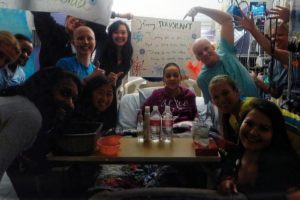
Against everyone’s better judgment, I boarded a flight a week later. I finished treatment in August and did not want to miss any classes. I booked my own flight and talked the doctor into moving the surgery to take the chords out of my chest up. I was getting ready for school down 50 pounds, no hair left on my body, a compromised immune system, and a severely damaged heart. Chemo causes the heart to not be as active and thicken up. Before I left, my dad and I went to see a cardiologist who said I would never lace up my skates again.
We decided to not tell my mom this part, but I got another test done before going back on the ice and the cardiologist said my heart was going in the right direction so I could proceed with caution. I flew across the country to New York where I was determined to prove everyone wrong and play NCAA Division I hockey.
Eventually that day came, but it was a long and drawn out return. It felt incredible when I stepped on the ice. There’s something about the clear, unscathed ice surface that has been calming for as long as I could remember. It’s where I grew up. It’s where I’m meant to be. Sure, the process of regaining strength was slow. My lungs were weak and my heart was weaker, but with each day brought a renewed sense of purpose. My coach was careful to limit my ice times as my strength grew slowly and I was still getting monthly blood draws at school to keep a careful eye on my recovery. One blood draw scare in November forced me to have a bone marrow biopsy because they thought the cancer had come back. After I left, I went straight back to practice to wait for the call because there was nowhere else I wanted to be but on the ice if I heard bad news.
Luckily, the tests came back negative and I was ready to go.
My return to playing an actual, full out college game was getting closer, and I would not allow leukemia cells to again tear away all semblance of normalcy from my life. This was a hard fought, carefully devised battle a year in the making, and I would be lying if I said my return to the game on January 4, 2013, wasn’t the best day of my life.
Oh, there were a lot of great days before this one.
– Finding out one of my siblings was an exact bone marrow match.
– Having Kelly Clarkson recognize our video on social media.
– Beating the beast that attempted to destroy my life.
But being able to play hockey again? … That was the best day of my life.
College came and went in the blink of an eye. After sitting out a year of game situation hockey, with the completion of college came my contract with the Ottawa Senators, a day I thought may never have come during my battle. This was the way I had envisioned my life: following in my dad’s footsteps with his former team. I had fought so hard for so long that this day just made sense.
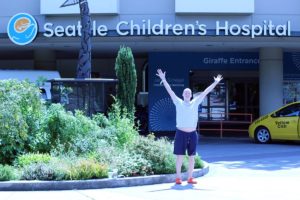
Looking back now, the strongest people I know aren’t on the ice. Through the sterile white double doors of the pediatric oncology floor are the most incredible fighters, just begging for a way to live their lives. It is the scariest, yet the most beautiful place you will hopefully never have to visit.
We have seen the most incredible children succumb to this beast with their family left in the wake, trying desperately to gain some semblance of normalcy as they are forced to pick up the scattered pieces of this absolute jigsaw of a disease. We have seen doctors scrambling to prolong the days of a terminal patient so their families can make their last memories.
My goal would be to eventually be a spokesperson for childhood cancers with the entire hockey world behind me. It would be a huge step in the diagnosis and funding for pediatric cancers worldwide. They say things happen for a reason. Prior to cancer, I might not have chosen that path, but now that I’ve traveled it, I understand fully the reason for what happened to me.
Life is filled with moments that change you in the most incredible ways. The people you meet, the places you go, the person you become. Cancer made me who I am today. It’s made me so much more appreciative of life than I ever knew possible. It’s made life so much more brilliant. Being able to live a normal life is the coolest thing for me because I never thought I would be able to again.
Every day is an adventure and I wouldn’t change it for anything. Every time I step on the ice, it’s more than just a game or a practice for me. It’s a chance to live my life. As time passes and the memories behind those white sterile doors begin to fade, I will never forget that feeling of the first time my skates hit the ice after beating the beast.

































